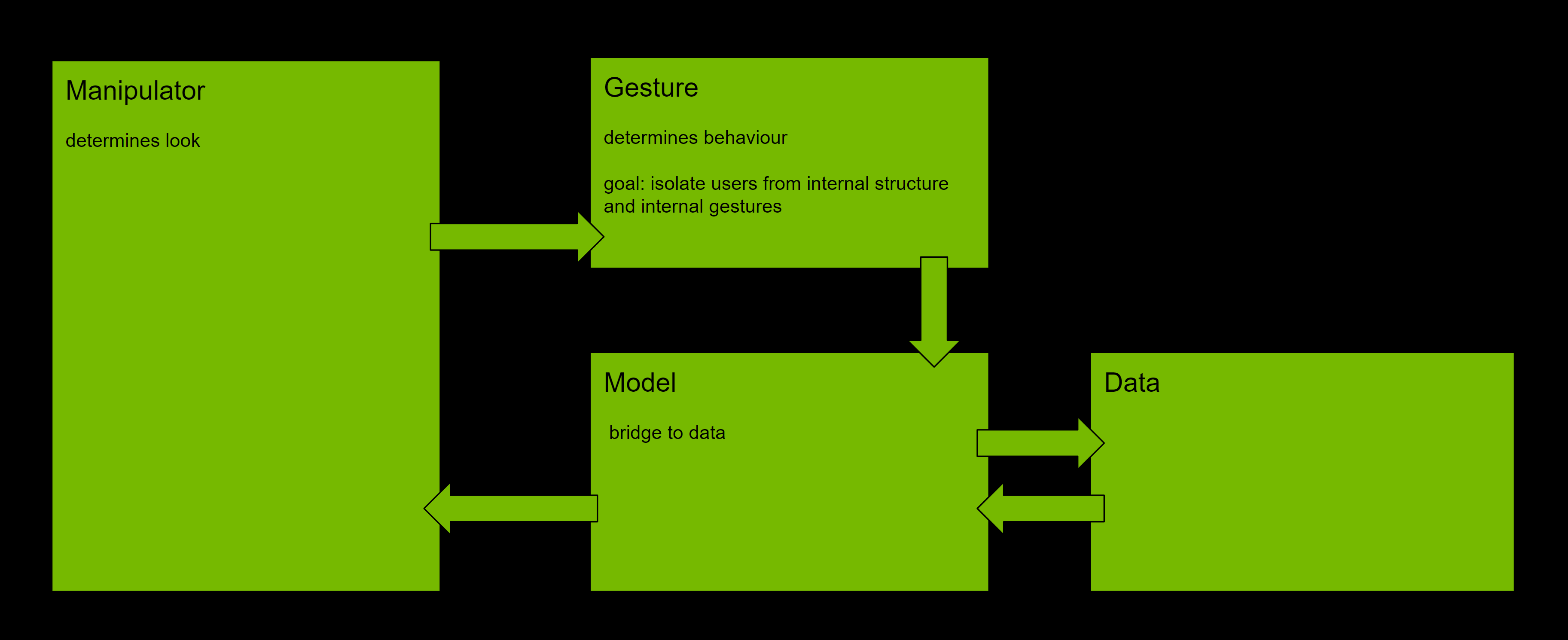Manipulator

Manipulator provides a model-based template that is flexible for implementing navigation and editing objects, points, and properties. It’s a container that can be reimplemented. It can have a model.
Immediate mode
It’s possible to regenerate the content of the Manipulator item by calling
the invalidate method. Once it’s called, Manipulator will flush the old
children and execute build_fn to create new ones. Suppose the invalidate
method is called inside build_fn. In that case, Manipulator will
call build_fn every frame, which provides, on the one hand, a maximum of
control and flexibility to the scene configuration. Still, on the other hand,
it also generates a continuous workload on the CPU.

class RotatingCube(sc.Manipulator):
def __init__(self, **kwargs):
super().__init__(**kwargs)
self._angle = 0
def on_build(self):
transform = sc.Matrix44.get_rotation_matrix(
0, self._angle, 0, True)
with sc.Transform(transform=transform):
sc.Line([-1, -1, -1], [1, -1, -1])
sc.Line([-1, 1, -1], [1, 1, -1])
sc.Line([-1, -1, 1], [1, -1, 1])
sc.Line([-1, 1, 1], [1, 1, 1])
sc.Line([-1, -1, -1], [-1, 1, -1])
sc.Line([1, -1, -1], [1, 1, -1])
sc.Line([-1, -1, 1], [-1, 1, 1])
sc.Line([1, -1, 1], [1, 1, 1])
sc.Line([-1, -1, -1], [-1, -1, 1])
sc.Line([-1, 1, -1], [-1, 1, 1])
sc.Line([1, -1, -1], [1, -1, 1])
sc.Line([1, 1, -1], [1, 1, 1])
# Increase the angle
self._angle += 1
# Redraw all
self.invalidate()
# Projection matrix
proj = [1.7, 0, 0, 0, 0, 3, 0, 0, 0, 0, -1, -1, 0, 0, -2, 0]
# Move camera
rotation = sc.Matrix44.get_rotation_matrix(30, 50, 0, True)
transl = sc.Matrix44.get_translation_matrix(0, 0, -6)
view = transl * rotation
scene_view = sc.SceneView(
sc.CameraModel(proj, view),
aspect_ratio_policy=sc.AspectRatioPolicy.PRESERVE_ASPECT_FIT,
height=200
)
with scene_view.scene:
RotatingCube()
Model
The model is the central component of Manipulator. It is the dynamic data structure, independent of the user interface. It can contain nested data, but it’s supposed to be the bridge between the user data and the Manipulator object. It follows the closely model-view pattern.
When the model is changed, it calls on_model_updated of Manipulator. Thus,
Manipulator can modify the children or rebuild everything completely depending
on the change.
It’s abstract, and it is not supposed to be instantiated directly. Instead, the user should subclass it to create the new model.

class MovingRectangle(sc.Manipulator):
"""Manipulator that redraws when the model is changed"""
def __init__(self, **kwargs):
super().__init__(**kwargs)
self._gesture = sc.DragGesture(on_changed_fn=self._move)
def on_build(self):
position = self.model.get_as_floats(self.model.get_item("position"))
transform = sc.Matrix44.get_translation_matrix(*position)
with sc.Transform(transform=transform):
sc.Rectangle(color=cl.blue, gesture=self._gesture)
def on_model_updated(self, item):
self.invalidate()
def _move(self, shape: sc.AbstractShape):
position = shape.gesture_payload.ray_closest_point
item = self.model.get_item("position")
self.model.set_floats(item, position)
class Model(sc.AbstractManipulatorModel):
"""User part. Simple value holder."""
class PositionItem(sc.AbstractManipulatorItem):
def __init__(self):
super().__init__()
self.value = [0, 0, 0]
def __init__(self):
super().__init__()
self.position = Model.PositionItem()
def get_item(self, identifier):
return self.position
def get_as_floats(self, item):
return item.value
def set_floats(self, item, value):
item.value = value
self._item_changed(item)
# Projection matrix
proj = [1.7, 0, 0, 0, 0, 3, 0, 0, 0, 0, -1, -1, 0, 0, -2, 0]
# Move/rotate camera
rotation = sc.Matrix44.get_rotation_matrix(30, 30, 0, True)
transl = sc.Matrix44.get_translation_matrix(0, 0, -6)
scene_view = sc.SceneView(
sc.CameraModel(proj, transl * rotation),
aspect_ratio_policy=sc.AspectRatioPolicy.PRESERVE_ASPECT_FIT,
height=200
)
with scene_view.scene:
MovingRectangle(model=Model())